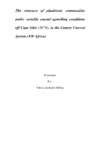Please use this identifier to cite or link to this item:
https://accedacris.ulpgc.es/jspui/handle/10553/11256
| Title: | The structure of planktonic communities under variable coastal upwelling conditions off Cape Ghir (31ºN), in the Canary Current System (NW Africa) | Authors: | Anabalón, V. | Director: | Aristegui, J. Morales van de Wyngard, Carmen |
UNESCO Clasification: | 251001 Oceanografía biológica | Keywords: | Ecosistema marino | Issue Date: | 2013 | Project: | CAIBEX (CTM2007-66408-CO2-02) CONICYT-FONDECYT (120504) |
Abstract: | Cape Ghir (~31°N), in the Canary Current System, is an area of permanent coastal upwelling with maximum intensity in summer-autumn, when a stronger across-shore thermal gradient and increased mesoscale activity are also present. The effects of spatial (a coastal-ocean transect with 7 stations) and temporal (5 dates: from December 2008 to October 2009) variations in upwelling conditions on the structure of planktonic communities was investigated. Multivariate analyses on the environmental conditions identified two main upwelling phases, weak and moderate; additionally, the most coastal station was, in all cases, distinct from the rest. Cluster formation was mostly influenced by nutrient concentration (space), and by sea surface temperature and number of days favourable to upwelling (time). These clusters were also representative of the spatial and temporal variability in the planktonic assemblages, implying that changes in the upwelling conditions do influence community structure. In terms of biomass, the dominant functional groups were mixed assemblages of dinoflagellates and ciliates (>51%); diatoms contributions were moderate to low (<35%) and their space and time variability was comparatively lower. The biomass in size fractions was dominated by the microplankton (>53%), which was mostly represented by dinoflagellates and ciliates. As autotrophic biomass, total chlorophyll-a was dominated by the nanoplankton fraction (flagellate and dinoflagellate); however, diatoms and dinoflagellates (microplanktonic) made the highest contributions to carbon biomass. This paradox probably results from suboptimal physiological conditions for diatoms and/or from a significant contribution by mixotrophs (microplanktonic dinoflagellate and ciliate taxa). Mean heterotrophic:autotrophic biomass ratios (pico-to microplankton) were mostly <=1 (normal pyramid) when the contribution of mixotrophs was considered but >1 (inverted pyramid) without it. The factors that might contribute to the structure of the phytoplankton assemblages in this system most likely include nutrient limitation in the upwelled waters, a narrow continental shelf, mesoscale activity dominated by the formation of a strong across-shore front and of a weak filament, and wind intensities which are mostly weak to moderate for most of the year. | Description: | Programa de Doctorado en Oceanografía | Faculty: | Facultad de Ciencias del Mar | URI: | https://accedacris.ulpgc.es/handle/10553/11256 | Rights: | by-nc-nd |
| Appears in Collections: | Trabajo final de máster |
En el caso de que no encuentre el documento puede ser debido a que el centro o las/os autoras/es no autorizan su publicación. Si tiene verdadero interés en el contenido del mismo, puede dirigirse al director/a o directores/as del trabajo cuyos datos encontrará más arriba.
Show full item recordPage view(s)
152
checked on May 17, 2025
Download(s)
222
checked on May 17, 2025
Google ScholarTM
Check
Share
Export metadata
Items in accedaCRIS are protected by copyright, with all rights reserved, unless otherwise indicated.
